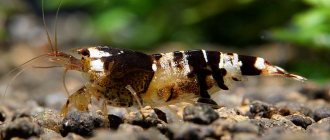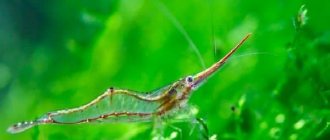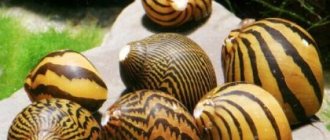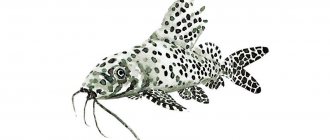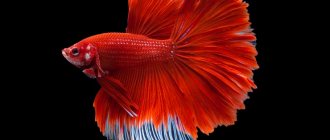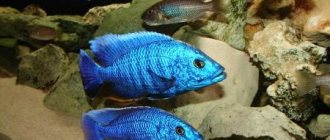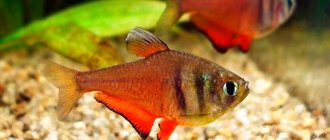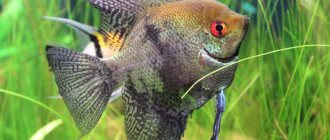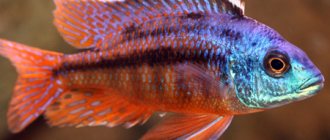This fish was first noticed in the rivers of North America, and thanks to its ability to eat mosquitoes and their larvae, Gambusia was spread around the world in order to eradicate the malaria epidemic. This fish is extremely tolerant of temperature and water conditions, which has allowed it not only to be distributed to more than 60 countries around the world, but also to be placed in aquariums. Thanks to the hard work of breeders, more than 40 species of mosquitofish can be seen.
Description and varieties
Gambusia is a small fish with a cylindrical body, which has a nondescript color (grayish or brown), as well as colorless fins. Males have several black spots on their body and a bright fin, while females have a faded coloring, without bright accents. Under good conditions in an aquarium they can live up to 2 years, but females live much less.
There are more than 40 species of Gambusia.
| Name | Description |
| Golden | Elongated body, yellow color, black dorsal fin. |
| Cuban | The body is elongated and laterally compressed, gray in color with lateral inclusions. |
| Dominican | Brown color, orange fins. |
| Nicaraguan | Elongated body, pointed muzzle, color either light gray or brown. |
The table shows the species that are found in domestic habitats.
Photo
MICRO-ASSEMBLY CARE DESCRIPTION PHOTO VIDEO COMPATIBILITY SPAWNING.
CARDINAL FISH CONTENTS BREEDING DESCRIPTION COMPATIBILITY PHOTO VIDEO.
BLACK XENOMIST - UNUSUAL FISH
CHEMIODOPSIS GRACEFUL: DESCRIPTION, NUTRITION, PHOTO
WHAT TO FEED GUPPY FRY IN THE FIRST DAYS AT HOME?
Behavior of mosquitofish in the aquarium
Gambusia is a restless, fast and agile fish. Often in an aquarium it can start a fight with the owners of lush fins or tails, biting off or tearing them. Very often the fish with which conflicts occur are their relatives, especially males. The main reason for such conflict is the desire for dominance.
Gambusia has 2 behavioral features:
- Gender change. Under severe stress, an aquarium fish burrows into the ground, after which it changes its sex. This phenomenon usually takes about 4 weeks.
- Devouring your offspring. With an unbalanced or monotonous diet, Gambusia is capable of eating both its own fry and the fry of its neighbors.
To avoid such problems you must:
- maintain a male to female ratio of 1:3;
- take a competent approach to feeding the fish;
- add fish with a similar temperament to the aquarium;
- create a large number of shelters for fish.
Under these conditions, you can create comfort and tranquility in the aquarium.
List of species
- Gambusia affinis (Baird & Girard, 1853) - common mosquitofish[3]
- Gambusia alvarezi Hubbs & Springer, 1957
- Gambusia amistadensis Peden, 1973
- Gambusia atrora Rosen & Bailey, 1963
- Gambusia aurata Miller & Minckley, 1970
- Gambusia beebei Myers, 1935
- Gambusia bucheri Rivas, 1944
- Gambusia caymanensis Regan, 1913
- Gambusia clarkhubbsi Garrett & Edwards, 2003
- Gambusia dominicensis Regan, 1913
- Gambusia echeagarayi (Alvarez, 1952)
- Gambusia eurystoma Miller, 1975
- Gambusia gaigei Hubbs, 1929
- Gambusia geiseri Hubbs & Hubbs in Hubbs & Springer, 1957
- Gambusia georgei Hubbs & Peden, 1969
- Gambusia heterochir Hubbs, 1957
- Gambusia hispaniolae Fink, 1971
- Gambusia holbrooki (Girard, 1859)
- Gambusia hurtadoi Hubbs & Springer, 1957
- Gambusia krumholzi Minckley, 1963
- Gambusia lemaitrei Fowler, 1950
- Gambusia longispinis Minckley, 1962
- Gambusia luma Rosen & Bailey, 1963
- Gambusia manni Hubbs, 1927
- Gambusia marshi Minckley & Craddock in Minckley, 1962
- Gambusia melapleura (Gosse, 1851)
- Gambusia monticola Rivas, 1971
- Gambusia myersi Ahl, 1925
- Gambusia nicaraguensis Günther, 1866
- Gambusia nobilis (Baird & Girard, 1853)
- Gambusia panuco Hubbs, 1926
- Gambusia pseudopunctata Rivas, 1969
- Gambusia punctata Poey, 1854 - Cuban Gambusia[3]
- Gambusia puncticulata Poey, 1854
- Gambusia rachowi (Regan, 1914)
- Gambusia regani Hubbs, 1926
- Gambusia rhizophorae Rivas, 1969
- Gambusia senilis Girard, 1859
- Gambusia sexradiata Hubbs, 1936
- Gambusia speciosa Girard, 1859
- Gambusia vittata Hubbs, 1926
- Gambusia wrayi Regan, 1913
- Gambusia xanthosoma Greenfield, 1983
- Gambusia yucatana Regan, 1914
Maintenance and care
Gambusia is a very unpretentious fish that can adapt to various conditions. Despite this, there are recommendations that should be followed:
- Deep aquarium. The capacity must be more than 40 liters. The shape of the aquarium is not important. It is also not necessary to have a filter. However, if you decide to install a filter, it is better to use an internal one so as not to scare the fry during reproduction.
- Settled water. The water should be hard and with minimal reaction. Temperature - vary from 20 to 24 degrees (at low temperatures the fish may hibernate). It is advisable to add sea salt, which is not only to the liking of gambusia, but also serves as a preventive measure against the development of diseases.
- Soil and decor. The soil can be any at the owner’s discretion, but it is advisable to plant the bottom with algae with hard leaves that the fish cannot eat. It is necessary to leave free space for swimming.
- Shelters. Create shelters, since Gambusia is not peaceful.
Your pet desperately needs a weekly water change. You should replace 30% of the aquarium water, after letting the water sit for about a day and adding sea salt to it at the rate of 1 spoon of salt per 5 liters of water.
Gambusia are very fond of salt water, and this also acts as a preventative against fungal infections.
Interesting Facts
In a number of countries, gambusia is considered useful and is used as a means of biological control of the malaria mosquito. Since the first half of the 20th century, these fish were considered the main weapon for eradicating malaria in South America, on the southern sea coasts of Russia and Ukraine. In 2008, several states of California created several reservoirs for these purposes, and the number of cases of infection with this dangerous disease has decreased significantly.
Grateful residents of Adler, Israel and Corsica erected monuments to her.
In Australia, on the contrary, they believe that mosquito fish have seriously undermined the ecological balance of the country’s lakes and rivers. There is a ban on their sale and maintenance.
Reproduction at home
Gambusia are viviparous fish. This aquarium fish spawns from March to November, with the largest number of litters occurring mainly in the summer. In one season, a female can produce up to 5 litters. Pregnancy in a female lasts about 3 weeks, it is difficult not to notice it by the rounded belly and the black spot near the anus. During one pregnancy, up to 200 fry are born. Since fertilization is internal, the fry are born fully formed and able to feed on their own.
A few days before giving birth, a pregnant female must be placed in another tank, densely filled with plants that will serve as shelters from the mother eating the fry. After birth, transfer it from the fry until the cubs are stronger.
The sex of fry at birth is 1:1, but most often older females give birth to more males. The first days of life, the fry must be fed up to 10 times a day, gradually reducing the number of meals.
Feeding
In nature, they eat mainly insects, and also a small amount of plant food. In a day, one fish can destroy up to a hundred malaria mosquito larvae, and in two weeks the count already goes into the thousands.
In a home aquarium, they eat both artificial, frozen or live food. Their favorite foods are bloodworms, daphnia and brine shrimp, but they will eat any food you offer them.
In our climate, you are unlikely to be able to offer them larvae of an analgesic mosquito (which is not something you should regret), but you can easily offer bloodworms. It is worth periodically adding food containing fiber.
Compatibility with other aquarium fish
Gambusia is an aggressive fish species that can bite off the fins of its relatives and neighbors, so it is worth excluding:
- goldfish;
- guppy;
- minors;
- tetra
Also, you should not add too slow fish to them: catfish, golden cockerel. Excellent neighbors for them will be:
- cardinals;
- zebrafish;
- barbs.
But for such predatory fish as acara, astronotus, and gambusia, they will become prey. It is very important that there are more females among their relatives, as conflicts for dominance will begin.
How to distinguish a female from a male?
Usually only experienced aquarists can distinguish the sex of a fish, but sex differences in mosquito fish are clearly pronounced. In the female:
- larger body size;
- the presence of a black spot near the anus;
- no bright fins.
Phenomena have happened in nature when fish change their gender after stress. At this time, the mosquitofish burrows into the ground for about 4 weeks. But after such a degeneration, your pet will become infertile.
Habitat
Occurs in shallow wetlands of North America and is widespread. Artificially introduced into river systems where it had not previously lived, in order to combat blood-sucking insects. Gambusias happily eat aquatic mosquito larvae. Requirements and conditions:
- Aquarium volume - from 40 liters.
- Temperature - 15–24 °C
- pH value – 6.0–8.0
- Water hardness - any (up to 30 dH)
- Substrate type - any
- Lighting - moderate
- Brackish water - no
- Water movement is weak
Fish parameters:
- Size - 3 - 6 cm.
- Food - any
Common diseases of mosquito fish
Despite the fact that the fish is extremely unpretentious in care and has a fairly strong immune system, diseases arise in it precisely because of errors in maintenance. They can be fungal and infectious, and poisoning also occurs.
Fungal infections occur due to the inappropriate condition of the aquarium:
- dirty water;
- leftover feed;
- high water temperature.
A white coating appears on the body, which is very similar to cotton wool or white mucus that envelops the body of the gambusia. First of all, sick individuals should be moved to another tank to avoid the spread of infection, which can not only infect other fish, but also lead to mass death. Fungal infections can be treated with salt baths.
Poisoning in mosquito fish occurs due to the accumulation of nitrogen compounds in water. Symptoms:
- black or red spots on the body;
- lethargy;
- bloating;
- decreased appetite.
It is necessary to purify the water and increase aeration in the water. In especially severe cases, drug treatment is prescribed. Basically, poisoning occurs en masse, which allows you to independently determine the cause of the disease.
Infectious diseases most often arise from decay products in water or when purchasing already diseased fish. The main symptom is whitish mucus on the body and ulcers. Infectious diseases are also treated with the help of medications.
When purchasing fish, it is recommended to carefully examine it for the presence of:
- ulcers;
- mucus;
- withered fin;
- bloated belly;
- eye problems.
If you notice at least one of these signs on the fish, refuse to buy it. Such symptoms indicate that the individual is unhealthy. If it is placed in an aquarium, this can lead not only to massive infection, but also to the death of your pets. It is also recommended that before placing a new fish in the aquarium, keep it in salt water for several days, separately from everyone else.
Gambusia is an unpretentious aquarium pet that adapts to all conditions. That is why it can be started by a person who has never had fish at home. However, you should add neighbors carefully and carefully, since Gambusia is quite aggressive and not peaceful, which can cause conflicts and even the death of neighbors. With proper care and maintenance, the fish can live up to 2 years and give birth to thousands of offspring. And in some cases it is even possible to see a gender change.
What to feed
In natural habitats, the main diet of mosquito fish consists of insect larvae and small crustaceans.
But in an artificial reservoir, this fish eats any high-quality dry food intended for small fish.
It is better to avoid live and frozen food, since their use carries a considerable risk of infecting the aquarium with parasites or infections.
